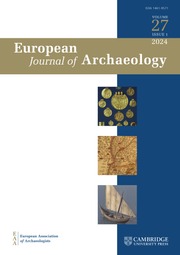Introduction
Inter-cultural contact and exchange networks are recurrent subjects in prehistoric research, as they potentially played a decisive role in shaping social structures. Support networks can be crucial in times of adversity, but exchange can also lead to relationships of inequality and dependency if access to them is restricted, or if exchanges are unequal. Determining the origin of raw materials or finished goods can be a useful starting point to investigate the movement of people, the transmission of knowledge, and, most importantly, the development of social relationships among the groups involved in these exchanges.
The importance and dynamism of the trading networks across the western Mediterranean is reflected in the multiple systems operating simultaneously between 3500 and 2200 cal bc, engaging different regions of Iberia (Broodbank, Reference Broodbank2013; Murillo-Barroso et al., Reference Murillo-Barroso, Peñalver, Bueno, Barroso, De Balbín and Martinón-Torres2018b, Reference Murillo-Barroso, Martín and Martinón-Torres2023; Broodbank & Lucarini, Reference Brookbank and Lucarini2020). On the one hand, the southern half of Iberia, North Africa, and Sicily were involved in the exchange of ostrich eggshell, ivory, and Sicilian amber (simetite)—all materials that are only rarely documented, if ever, in northern Iberian areas (Schuhmacher, Reference Schuhmacher, Bartelheim, Bueno and Kunst2017; Murillo-Barroso et al., Reference Murillo-Barroso, Peñalver, Bueno, Barroso, De Balbín and Martinón-Torres2018b; Odriozola et al., Reference Odriozola, Sousa, Mataloto, Boaventura, Andrade and Villalobos2019a). At the same time, copper objects and Bell Beaker pottery, assumed to have originated in Iberia, are documented in north-western Africa, supposedly having been exchanged for ivory or ostrich eggs (Harrison & Gilman, Reference Harrison, Gilman and Markotic1977). On the other hand, north-eastern Iberia, southern France, Sardinia, and Italy were involved in the exchange of obsidian, flint, and Baltic amber (Villalba, Reference Villalba and Weisgerber2003; Vaquer & Lea, Reference Vaquer, Léa, Blasco, Edo and Villalba2011; Pétrequin et al., Reference Pétrequin, Errera, Martín, Fàbregas, Vaquer, Borrell, Borrell, Bosch, Clop and Molist2012; Terradas et al., Reference Terradas, Gibaja, Borrel, Bosch, Palomo, Chambon, Gibaja, Goude and Perrin2016), which in turn is only exceptionally recovered in the southern half of Iberia.
Against this background, the north-eastern region of the Iberian Peninsula is a particularly interesting area for the study of amber for two main reasons. First, on the basis of the evidence available so far, this area appears to follow a different tradition from the rest of the Iberian Peninsula (and particularly from the southern half) in terms of consumption patterns. Specifically, amber objects increase significantly during the third millennium bc and decrease dramatically (if not altogether) after 2200 bc until approximately 1300 bc. However, in the north-eastern Iberian Peninsula, with some very early exceptions (Murillo-Barroso et al., Reference Murillo-Barroso, Martín and Martinón-Torres2023), the vast majority of objects seem to date to the second millennium bc (Murillo-Barroso et al., Reference Murillo-Barroso, Peñalver, Bueno, Barroso, De Balbín and Martinón-Torres2018b). Second, due to its greater continental connection with southern France, the north-eastern part of the Iberian Peninsula is one of the regions where the first imports of Baltic amber are documented (Murillo-Barroso et al., Reference Murillo-Barroso, Martín and Martinón-Torres2023). It is precisely Baltic amber, not Sicilian amber, that predominates in the north-eastern Iberian Peninsula, unlike in the southern half of the peninsula, where Sicilian amber is documented for the first time in the fourth millennium bc and widely used during the third millennium bc. Therefore, north-eastern Iberia is a crucial target area to document the arrival of this new type of amber, replacing ambers from other sources from approximately 1300 bc onwards.
Since Jordi Rovira i Port published an article on amber and glass paste objects from the north-eastern Iberian Peninsula nearly thirty years ago (Rovira i Port, Reference Rovira i Port1994), no comprehensive work has been published on the amber recovered from this region, and their connection to different regional traditions and their respective contact networks, with the exception of highly localized studies on a bead from Forat de Conqueta (Núñez et al., Reference Núñez, García-Guixé, González-Marcén, Mora Torcal, Halinen, Heyd and Mannermaa2022) and another from Cova del Frare (Murillo-Barroso et al., Reference Murillo-Barroso, Martín and Martinón-Torres2023).
In this article, we present new data and review all the evidence available for amber finds in late prehistoric north-eastern Iberia, documenting their current state of preservation, discussing their possible chronological attribution, and submitting the results of provenance analyses of all available objects within the framework of the exchange systems identified in different regions of the Iberian Peninsula.
Archaeological Background
In his pioneering work, Rovira i Port (Reference Rovira i Port1994) mentioned fourteen archaeological sites from which he documented forty amber items (Figure 1). In some cases, he cites references from classic works of the early twentieth century, although these references do not always correspond with the material remains that are currently kept in museums. Most of these sites with amber pieces are caves (some of them used for funerary purposes) and megalithic tombs in which multiple individuals were buried, making it impossible to associate the amber objects directly with specific individuals. The material culture of these sites can mostly be placed within the Bronze Age, although in some cases there are also artefacts dating to as early as the Copper Age or as late as the Early Iron Age, such as the glass paste beads of orientalizing style at El Bosc, which suggests continuity in use of these tombs and caves, and defies any attempt at dating the amber with precision (see Supplementary Material S1 for further description of the archaeological contexts).
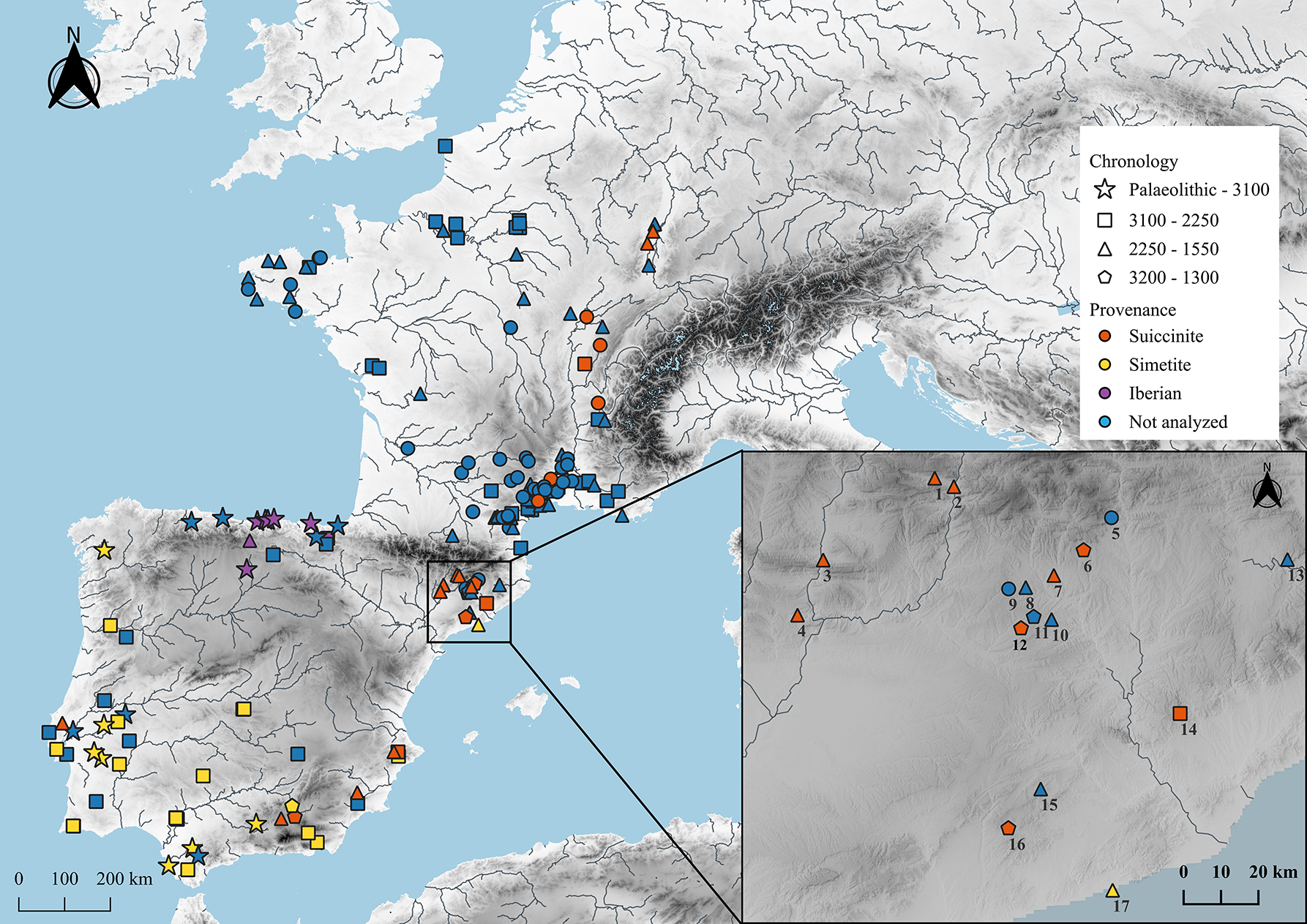
Figure 1. Amber finds in north-eastern Iberia and France. Bottom right: archaeological sites in north-eastern Iberia. 1. Pedra Cabana (El Vilar de Cabo, Lleida); 2. Cabana del Moro de Colomera (Organyà, Lleida); 3. La Cueva de Muricecs; 4. La Cova del Forat de Conqueta (Santa Linya, Lleida); 5. Can Maurí (Berga, Barcelona); 6. El Bosc (Correà, Barcelona); 7. La Fossa del Gegant (Solsona, Lleida); 8. Bullons (Solsona, Lleida); 9. Cal Rajolí (Solsona, Lleida); 10. Can Cuca (Solsona, Lleida); 11. Collet (Solsona, Lleida); 12. La Pera (Solsona, Lleida); 13. Les Pixarelles (Tavertet, Barcelona); 14. Cova del Frare (Matadepera, Barcelona); 15. Cova de la Roca del Frare (La Llacuna, Barcelona); 16. Cova de El Garrofet (Querol, Tarragona); 17. Cova del Gegant (Sitges, Barcelona).
After Rovira i Port’s Reference Rovira i Port1994 publication, amber beads were discovered in three additional sites: the Muricecs cave, where the most substantial collection of amber beads in the region was found, consisting of over 135 beads (Gallart i Fernàndez, Reference Gallart i Fernàndez2006; Murillo-Barroso & Martinón-Torres, Reference Murillo-Barroso and Martinón-Torres2012); the Forat de la Conqueta cave, where a disc-shaped bead and a spacer bead were recovered (González-Marcén et al., Reference González-Marcén, Mora Torcal and Roda Gilabert2010; Núñez et al., Reference Núñez, García-Guixé, González-Marcén, Mora Torcal, Halinen, Heyd and Mannermaa2022); and the Cova del Gegant, which yielded two more beads (Daura et al., Reference Daura, Sanz, Pike, Subirà, Fornós and Fullola2010; Odriozola et al., Reference Odriozola, Sousa, Mataloto, Boaventura, Andrade and Villalobos2019a).
We revisited all the contexts published by Rovira i Port, as well as some of the new ones, and all the preserved amber pieces were analysed using Fourier transform infrared spectrometry (FTIR) to determine the origin of the raw material used. A detailed description of each of the sites, their associated material culture, and the amber beads can be found in Supplementary Material S1.
Materials and Methods
For this study, a total of twenty-one pieces from six sites were analysed (Figure 2), to which we can add the previously published analyses of another four sites (Table 1).
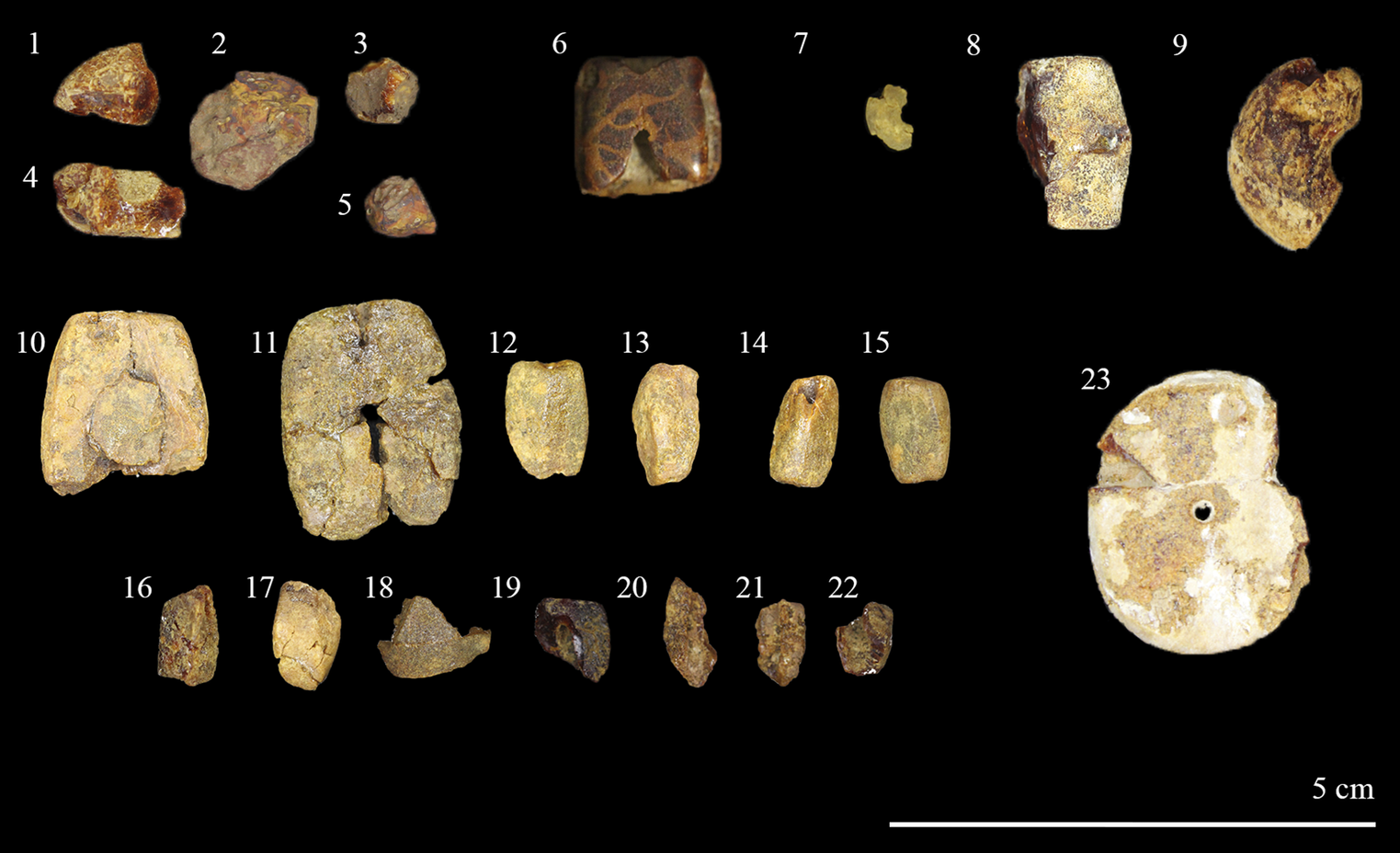
Figure 2. Materials analysed. 1. 2508a, 2. 2508e, 3. 2508c, 4. 2508b and 5. 2508d from Cabana del Moro de Colomera; 6. 1339 and 7. 4855 from Forat de la Conqueta; 8. bead from Fossa del Gegant; 9. G/33 from El Garrofet; 10. 1837_1, 11. 1837_2 and 1837_16 (two fragments), 12. 1837_15, 13. 1837_6, 14. 1837_7, 15. 1837_8, 16. 1837_9, 17. 1837_12, 18. 1837_13, 19. 1837_14, 20. 1837_16, 21. 1837_17 and 22. 1837_18 from El Bosc (note that 20 and 21 are two fragments of the same bead); and 23. 3434 from La Pera.
Table 1. Analysed amber objects.
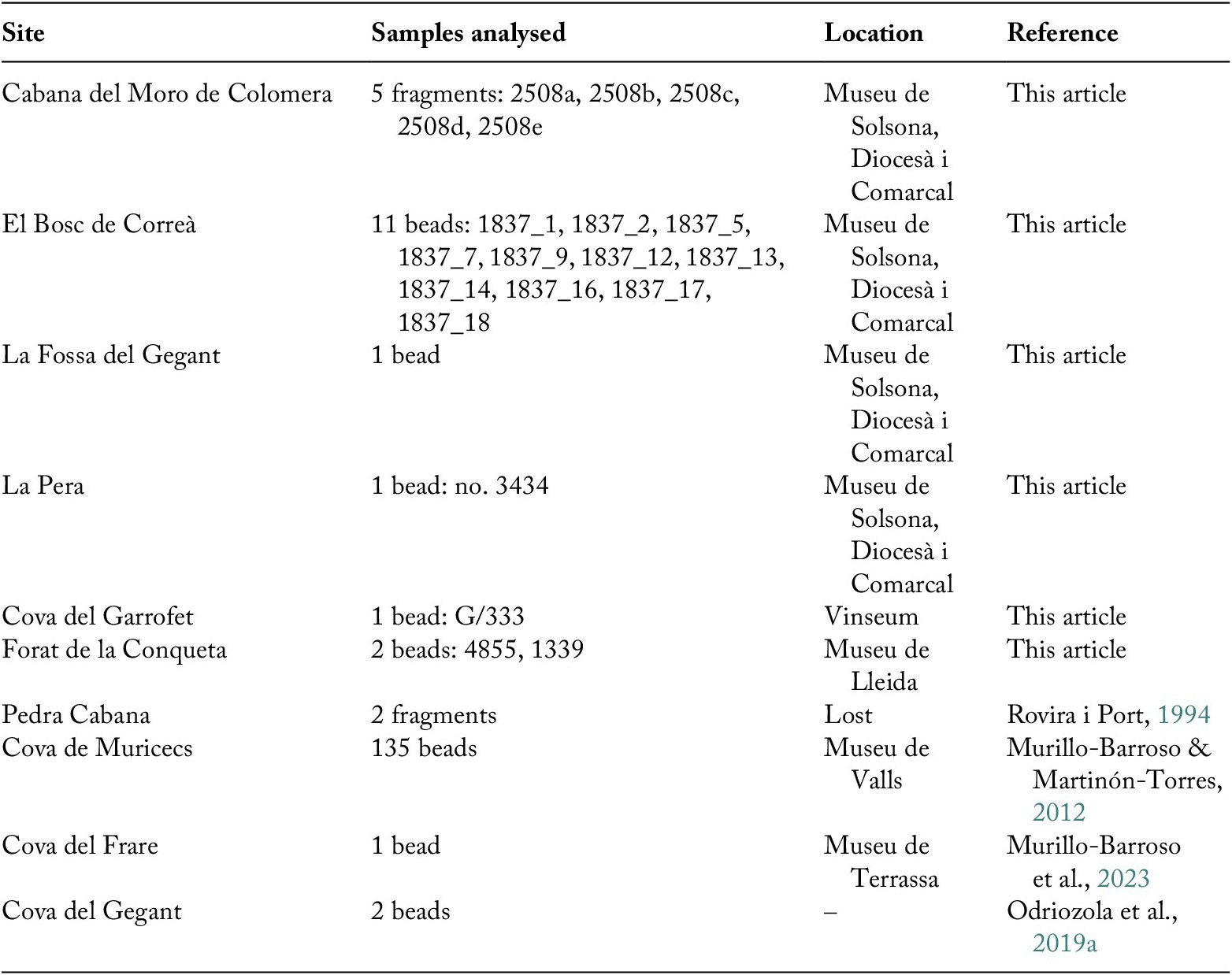
The samples were analysed at the Centro de Instrumentación Científica of the University of Granada using a FTIR-6200 type A with an attenuated total reflectance attachment. Each sample was analysed fifty times in the range of 4000-400 cm-1 with a resolution of 4 cm-1. The spectra are presented in infrared transmission.
Samples 2508d and 2508e from Cabana del Moro de Colomera were also analysed using a scanning electron microscope with energy-dispersive X-ray spectroscopy (SEM-EDS) at the Laboratorio de Microscopía Electrónica y Microanálisis (MicroLab) of the Instituto de Historia, CSIC (IH, CSIC) in Madrid. For this, a variable pressure SEM Hitachi S-3400n (Type II) was used, with secondary electron and backscattered electron detectors. For EDS analysis, a Bruker Quantax 4010 (SDD) detector coupled to the SEM was used, with a Bruker AXS SVE III processor.
Results
The analysed samples can be classified into three groups: i) two samples that were catalogued as amber but turned out not to be amber; ii) pieces that appeared to be amber with a characteristic translucent aspect; and iii) a surface degradation layer from which an independent sample could be taken from one of the beads from El Bosc. We will discuss their results in turn. The raw data for all the spectra are available as Supplementary Material S2.
Samples without amber-like appearance
Beads 2508d and 2508e from Cabana del Moro de Colomera are reddish in colour but not translucent, and the analyses confirmed that they are not amber objects, as initially suspected. The resulting spectra did not show the characteristic amber peaks at ~3500, ~2900, and ~1700 cm-1, nor the typical ancient resin peaks at ~1450 and ~1380 cm-1 corresponding to -CH2- and -CH3- bending modes. In both cases, the spectra were very similar (Table 2; Figure 3), suggesting that they were made of the same raw material. The SEM-EDS analyses showed an elemental composition mainly consisting of FeO (64.8 per cent) with impurities of SiO2 (10.9 per cent) and Al2O3 (20.8 per cent). This composition is very similar to that of red ochre and also compatible with the pigment red bolus—an iron aluminium silicate. The FTIR spectra of the samples from Cabana del Moro de Colomera shows a higher affinity with the latter (Table 2) (Čiuladienė et al., Reference Čiuladienė, Luckutė, Kiuberis and Kareiva2018). The main difference lies in the presence of O–H stretching bands at 3689 and 3616 cm–1, characteristic of kaolin (Al2Si2O5(OH)4), which are present in both the Cabana del Moro de Colomera samples and red bolus pigment spectra but absent in the spectra of hematite or red ochre. The asymmetric Si–O–Si stretching band at 1000 cm–1 observed in the Cabana del Moro de Colomera and red bolus pigment spectra might be related to the stretching band at 1028 cm–1 of the hematite and red ochre spectra, and the absorption peaks at 523, 455, and 429 cm–1 are due to Fe–O vibrations (Čiuladienė et al., Reference Čiuladienė, Luckutė, Kiuberis and Kareiva2018, Reference Čiuladienė, Beganskienė, Senvaitienė and Kareiva2021). Therefore, we believe that the samples from Cabana del Moro de Colomera could be fragments of red bolus pigment, similar to ochre.
Table 2. Main peaks of FTIR spectra from samples at Cabana Moro de Colomera.

S = secondary peaks
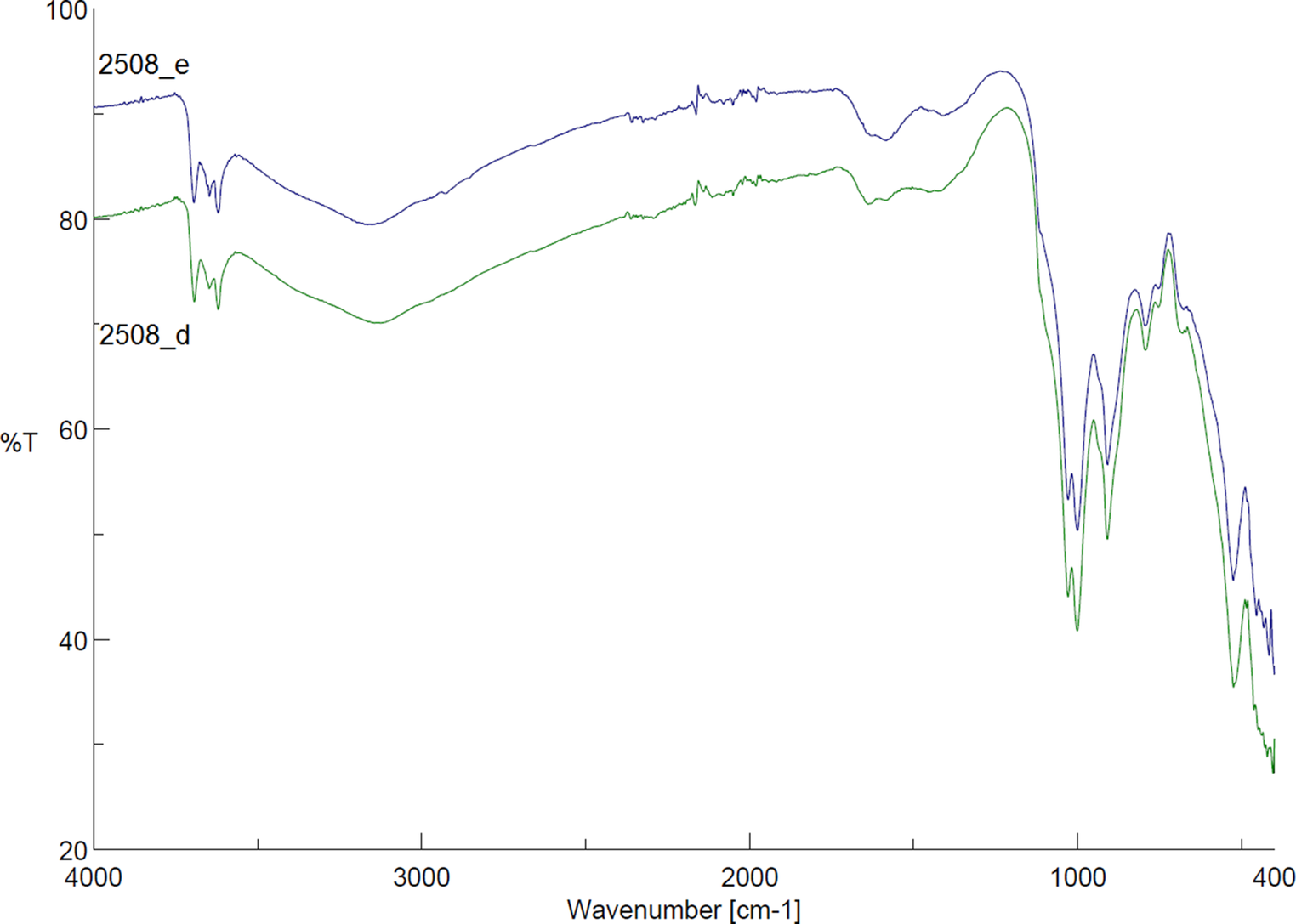
Figure 3. FTIR spectra of samples 2508_d and 2508_e from Cabana del Moro de Colomera.
Samples apparently made of amber
The remaining analysed samples exhibit the characteristic spectrum of amber, confirming that they are indeed made of this fossil resin. Notably, there is a high degree of homogeneity among all the samples—except for one of the beads from Forat de la Conqueta, discussed below. In almost all cases, the samples appear to be made of the same type of amber (Table 3; Figure 4; Supplementary Material S2).
Table 3. FTIR results of analysed amber samples.
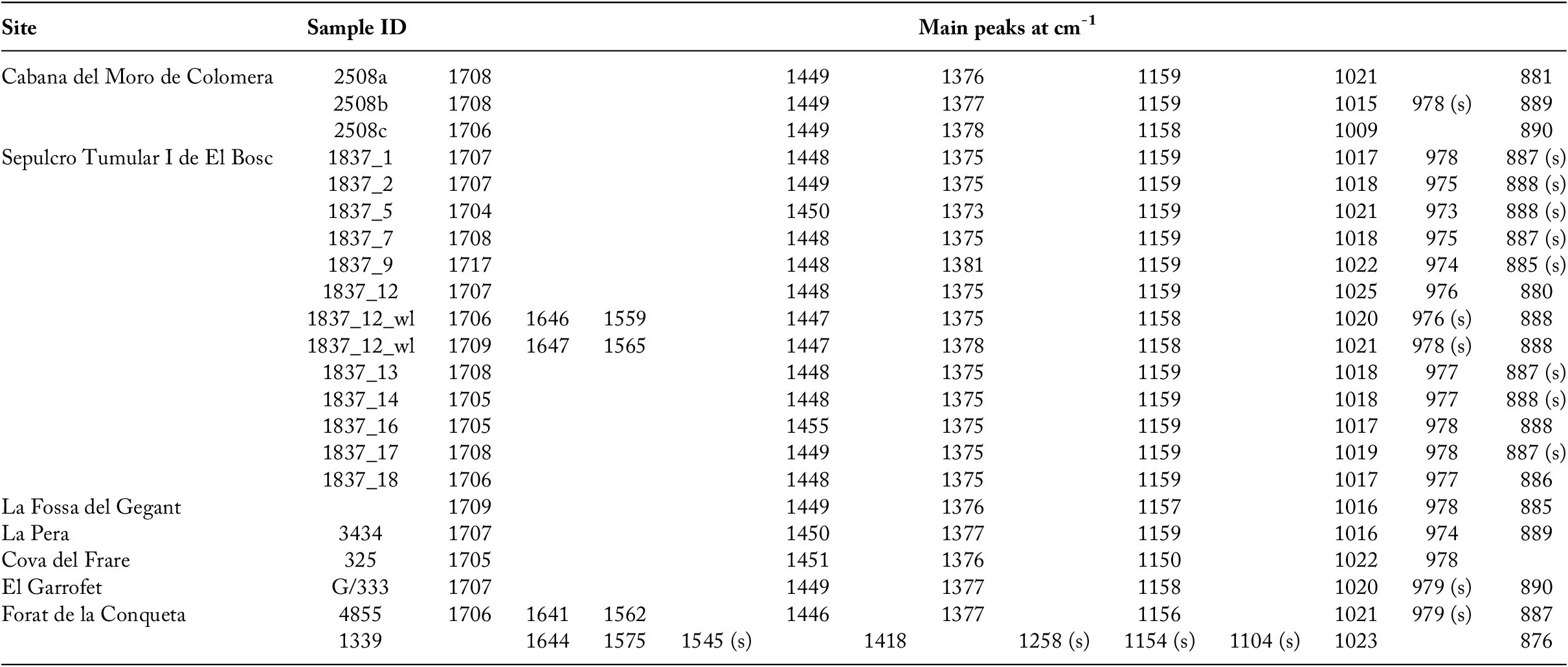
S = secondary peaks, wl = weathered layer

Figure 4. FTIR spectra of amber samples. a) Forat de La Conqueta_485;5; b) El Garrofet; c) Fosa del Gegant; d) La Pera_3434; e) El Bosc_18; f) El Bosc_17; g) El Bosc_16; h) El Bosc_14; i) El Bosc_13; j) El Bosc_12; k) El Bosc_9; l) El Bosc_7; m) El Bosc_5; n) El Bosc_2; o) El Bosc_1; p) Cabana del Moro de Colomera 2508_c; q) Cabana del Moro de Colomera 2508_b; r) Cabana del Moro de Colomera 2508_a. The ‘Baltic shoulder’ is highlighted in light grey for the sake of clarity.
In all cases, a strong peak is observed at ~2925 cm-1 and a secondary peak at 2866 ±4 cm-1, corresponding to methylene groups. The band at ~1708 cm-1 corresponds to carbonyl groups, and the bands at ~1448 and ~1376 cm-1 can be attributed to alkyl groups, with the band at ~1448 cm-1 corresponding to -CH2- and -CH3- bending (δ), and the band at ~1376 cm-1 being due solely to -CH3 bending. These characteristics are common to all ambers. Two other bands, at ~1020 and ~976 cm-1, are also consistently present in amber spectra and can be assigned to different C-O bonds (Rodríguez Montoro, Reference Rodríguez Montoro2013). The band at 886±4 cm-1 corresponds to exocyclic methylene groups, to C-H bending, and is commonly found in amber spectra, although tests by Guiliano and colleagues (Reference Guiliano, Asia, Onoratini and Mille2007) showed that this band can disappear due to exposure to heat.
The most interesting spectral region for defining different amber species, and therefore for determining their provenance, is the broad range between 1500 and 900 cm-1. This is known as the amber ‘fingerprint’ region, where different species exhibit distinct patterns. The distinct spectrum of Baltic amber is characterized by a strong absorption peak at ~1157 cm-1, which can be attributed to the stretching of the single C-O ester bond, preceded by a horizontal band between ~1250 and 1180 cm-1 that may have a greater or lesser slope depending on the conservation conditions of the piece (Beck et al., Reference Beck, Wilbur and Meret1964, Reference Beck, Wilbur, Meret, Kossove and Kermani1965; Beck, Reference Beck1982). This exclusive feature is referred to as the ‘Baltic shoulder’, which, together with the presence of succinic acid, is a diagnostic marker of Baltic succinite.
As we can see, the ‘Baltic shoulder’ is clearly identified in all the analysed samples bar one, and all the peaks match those of the reference spectrum of Baltic amber. In the case of bead 4855 from Forat de la Conqueta, the spectrum shows the ‘Baltic shoulder’ but also two additional peaks at 1641 and 1562 cm-1, which can be attributed to a degradation process (see below) and therefore do not compromise the provenance attribution. Therefore, Baltic succinite can be proposed as the raw material used for all the analysed amber samples, except for one.
The only piece that differs from the rest is the spacer-bead 1339 from Forat de la Conqueta. Its spectrum is characterized by intense absorption peaks at 2922 and 2855 cm-1, related to single C-H bonds produced by methylene groups, and an O-H bending band at 1644 cm-1. The spectral range of 1550–650 cm-1 contains the largest number of absorption features, with peaks at 1575, 1418, 1023, 876, 824, and 669 cm-1. These bands can be assigned to the C-H bending motions of methyl and methylene functional groups, and to absorption bands generally assigned to C-O single bonds, such as the intense band at 1023 cm-1 from the -O-CH3 and -O-CH2-CH3 ester groups, although not all absorption features in this range can be assigned to a specific molecular functional group (Tappert et al., Reference Tappert, Wolfe, Mckellar, Tappert and Muehlenbachs2011). The spectrum also has shoulders or secondary peaks at 1701 cm-1, associated with carboxylic acid groups, at 1258 cm-1 associated with the νs (C-O) bond, at 1154 cm-1, which can be attributed to the stretching of the single C-O ester bond, and at 1104 cm-1 (Table 3; Supplementary Material S2).
The spectrum is mostly characterized by a very large hydroxyl peak at ~3400 cm-1 which is attributed to the symmetrical stretching of O-H bonds. This peak is characteristic of gums (Tappert et al., Reference Tappert, Wolfe, Mckellar, Tappert and Muehlenbachs2011; Thombare et al., Reference Thombare, Mahto, Singh, Chowdhury and Ansari2023), whereas it is weaker in resins and volatile-rich resins or in younger ambers such as Baltic succinite, while it is absent in older Cretaceous Iberian ambers. The similarity with the FTIR spectra of gum is strong (Figure 5). However, it shows two peaks at 1644 and 1575 cm-1 that are usually absent in gum samples but present in weathered amber samples (see below), so their presence may be related to the degradation processes of the raw material. The characteristic ‘Baltic shoulder’ is absent in this sample.
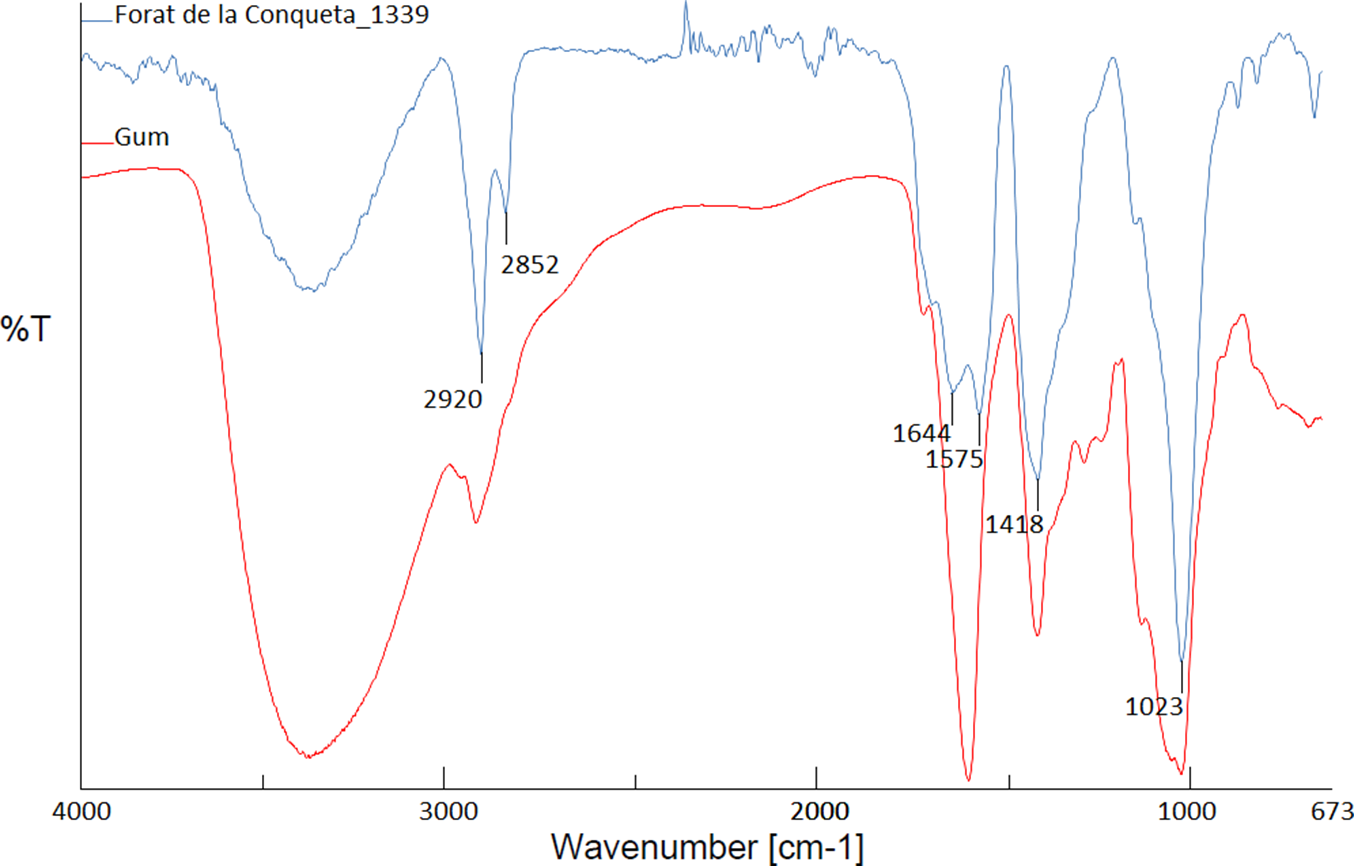
Figure 5. FTIR spectrum of sample 1339 from Forat de la Conqueta compared to the FTIR spectrum of a gum sample from Tappert et al., Reference Tappert, Wolfe, Mckellar, Tappert and Muehlenbachs2011.
Surface oxidation layer
In the case of bead 1837_12 from El Bosc, we were able to extract two samples from the surface oxidation layer and a third one from the amber core, allowing us to evaluate the spectral changes associated to post-depositional weathering.
The spectrum of the amber core, like those of the previous samples, corresponds to the succinite spectrum, presenting the characteristic ‘Baltic shoulder’ (Table 3; Figure 6). In the spectra from the weathered layer, the ‘Baltic shoulder’ is still visible but it shows a slight upward slope rather than being flat. Beck et al. (Reference Beck, Wilbur, Meret, Kossove and Kermani1965) proposed that this horizontal band would fade slightly, resulting in a downward slope, due to oxidation. This is indeed the case for some of the samples reported above (Figure 6). However, in the case of bead 1837_12, the pattern is precisely the opposite: instead of a downward slope, the shoulder has become more pronounced, almost forming a secondary peak. Experimental studies and further analyses of amber cores vs weathered surfaces would be needed to determine under what weathering conditions this band fades or becomes more pronounced, and to what extent soil aridity, ambient humidity, or salinity may contribute in either direction.
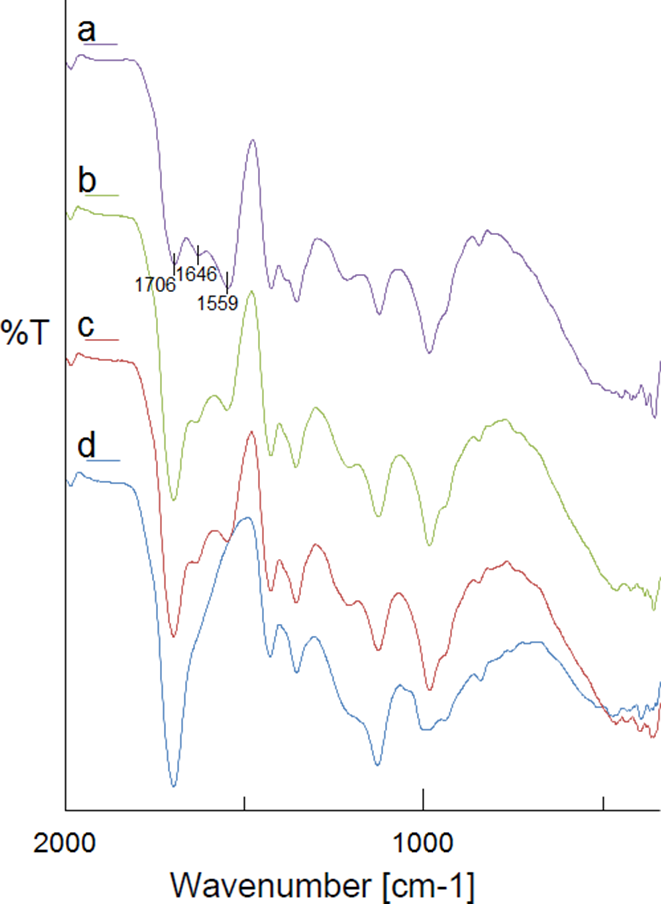
Figure 6. FTIR spectra of sample 4855 from Forat de La Conqueta (a) compared to the weathered layer from the El Bosc_12 bead (b, c) and the amber core of the same bead (d).
Besides this feature, the main spectral alteration appears in the range between 1750 and 500 cm-1, where peaks appear at ~1645 and ~1560 cm-1 that may be related to acidic carboxylic groups (Rodríguez Montoro, Reference Rodríguez Montoro2013). These features are also found in sample 4855 from Forat de la Conqueta, which also shows signs of surface degradation.
Discussion
It is striking that out of the thirty-one prehistoric amber beads analysed from the north-eastern Iberian Peninsula, twenty-nine have a Baltic origin. This pattern contrasts significantly with other regions of Iberia, where Baltic amber is scarcely present before 1550 bc, when it occurs in association with broader socio-economic changes occurring during the Late Bronze Age/Early Iron Age. In the southern half of Iberia, most prehistoric amber, at least since the second half of the fourth millennium bc, originates in Sicily (Murillo-Barroso et al., Reference Murillo-Barroso, Martínez-Sánchez and Vera-Rodríguez2018a). One bead from La Almoloya and another bead from Cueva de las Ventanas, dated to the middle of the second millennium bc, are the only examples of Bronze Age Baltic amber recovered in the southern half of Iberia out of the more than 200 beads analysed in the area. In addition, two beads found in the megalithic structures of Llano de la Sabina can be proposed as having a Baltic origin. However, these graves were reused during the Early Iron Age, making it difficult to assign them securely to a chronological phase. On the Cantabrian coast and in the northern Iberian region, only the bead from the Larrate dolmen (which accounts for 12 per cent of the analysed beads in the region) can be considered Baltic; it was recovered from the outer area of the tumulus and hence its chronological attribution is not entirely certain (Álvarez-Fernández et al., Reference Álvarez-Fernández, Peñalver and Delclòs2005; Murillo-Barroso et al., Reference Murillo-Barroso, Peñalver, Bueno, Barroso, De Balbín and Martinón-Torres2018b). While we cannot be sure that all the analysed beads from the north-eastern Iberian region can be dated to before 1550 bc (see Supplementary Material S1), it is nonetheless evident from the amber data that southern and north-eastern Iberia were part of different exchange networks. The frequency and spatial distribution of Baltic amber in France suggests that it may have entered from the north following fluvial routes, with a significant concentration of amber objects the southern area (du Gardin, Reference du Gardin1986, Reference du Gardin, Beck, Loze and Todd2003) (Figure 1). The close contacts between these communities and those in north-eastern Iberia would have facilitated the arrival of Baltic amber in the Iberian Peninsula. Interestingly, while natural passageways across the Pyrenees allowed the movement of amber, the river Ebro appears to have served as a stronger cultural boundary.
Special mention should be made of the site of Forat de la Conqueta, which has a broad chronology (3400–1100 bc) and where two completely different beads were recovered. The first is a simple and common type in the Iberian Peninsula; despite showing slight surface degradation, the spectrum clearly displays the main characteristics of Baltic succinite. The second item, a spacer-bead, is likely to have been highly valued, as it was repaired and reused after it was broken (Martínez-Moreno, Reference Martínez-Moreno2010; Núñez et al., Reference Núñez, García-Guixé, González-Marcén, Mora Torcal, Halinen, Heyd and Mannermaa2022). This type of spacer-bead is well-documented in the Iberian Peninsula in other raw materials, but it had not been previously documented in amber (Carrasco Rus et al., Reference Carrasco Rus, Pachón and Gámiz2009). The only other possible exception might be the now lost spacer-bead from Les Pixarelles, for which only a brief description is available (Rovira i Port, Reference Rovira i Port1994: 72). Conversely, amber spacer-beads are more commonly documented in Europe, from Greece to Britain, being particularly frequent in Germany and France (du Gardin, Reference du Gardin1986, Reference du Gardin, Beck, Loze and Todd2003). In France, at least forty-nine spacer-beads are known, and all the French beads analysed to date have been shown to be of Baltic origin (Pétrequin et al., Reference Pétrequin, Beck, Piningre, Hartmann and De Simone1987).
It would thus seem reasonable to propose an exogenous (and possibly Baltic) origin for the spacer-bead from Forat de la Conqueta (Núñez et al., Reference Núñez, García-Guixé, González-Marcén, Mora Torcal, Halinen, Heyd and Mannermaa2022). However, our FTIR spectrum does not show the characteristic ‘Baltic shoulder’, and instead bears a clear similarity to that of gum, a distinctive type of exudate that occurs together with resins in several taxa. Although these exudates are often not physically distinguishable from resins, their FTIR spectra are characterized by a very large hydroxyl peak at ~3400 cm-1 that does not occur in resins. At the same time, the FTIR spectra of gums from different species are very similar to each other; compositionally, they are primarily polysaccharide derivates with considerably lower amounts of terpenoids (Tappert et al., Reference Tappert, Wolfe, Mckellar, Tappert and Muehlenbachs2011).
When not fossilized, gum and volatile resins are more commonly used as adhesives than as raw materials for making beads. The Forat de la Conqueta bead does not appear to have any coating, as is known from other examples in Iberia (Odriozola et al., Reference Odriozola, Garrido Cordero, Daura, Sanz, Martínez-Blanes and Avilés2019b, Reference Odriozola, Garrido-Cordero, Sousa, Martínez-Blanes, Romero-García, Sánchez, Edo, Romero, Simón-Vallejo, Zambrana and Molina2024). It was most probably made of gum, although the possibility that it was coated with some type of gum that would have acted as an adhesive when it was repaired cannot be entirely discarded. In any case, it is evident from both its typology and treatment that this bead differs from the other objects documented in north-eastern Iberia, and particularly from the disc-shaped bead recovered at the same site.
All in all, our review of the amber objects from north-eastern Iberia highlights the regional diversity that characterizes the prehistory of the Iberian Peninsula and is evident in the technological, social, and cultural traditions that developed in its different areas (e.g. Lillios et al., Reference Lillios, Blanco-González, Lee and López-Sáez2016; Blanco-González et al., Reference Blanco-González, Lillios, López-Saéz and Drake2018), including the different social value given to specific materials. Access to ‘exotic’ materials as markers of social status has been related to the increase of social stratification in southern Iberia during the Copper Age. This trend would have been broken by the emerging Bronze Age elites (particularly evident in the El Argar society), who established new ideological and symbolic expressions whereby the role played by amber (and ‘exotica’) in the materialization of power was replaced by other raw materials, especially metals (Costa et al., Reference Costa, García Sanjuán, Murillo-Barroso, Parrilla, Wheatley, Sanjuán, Scarre and Wheatley2011; Murillo-Barroso & Montero-Ruiz, Reference Murillo-Barroso, Montero-Ruiz, Bartelheim, Bueno and Kunst2017). These social and cultural regions also developed different exchange networks. In particular, north-eastern Iberia shows a distinct tradition characterized by exchange networks oriented primarily towards southern France and the interior of the continent, rather than towards the western Mediterranean and North Africa. Even during the Palaeolithic, the lithic industry shows clear influences from southern France, albeit with local variations that reflect adaptations to the specific environmental and social conditions of the Iberian region. This suggests the existence of contact networks, shared traditions, and a flow of materials and technical knowledge between the two regions, facilitated by geographical proximity and the relative ease of communication through the Pyrenees, which acted as a fluid conduit.
The Neolithic and Copper Age in the Iberian Peninsula are marked by the intensification of exchange networks and the increased complexity of social structures. During the Neolithic and Copper Age, in north-eastern Iberia and southern France, communities known as ‘Sepulcros de Fossa’ (4200–3500 cal bc) and ‘Veraza’ (3500–2300 cal bc) developed, sharing a similar material culture on both sides of the Pyrenees and exchanging raw materials (Martín-Cólliga et al., Reference Martín-Cólliga, Petit and Maya2002), as evidenced by the presence of variscite from Can Tintorer (Gavá) in French megaliths or the arrival of flint from Vaucluse (France) in north-eastern Iberia (Herbaut & Querré, Reference Herbaut and Querré2004; Vaquer & Lea, Reference Vaquer, Léa, Blasco, Edo and Villalba2011; Mangado Llach et al., Reference Mangado Llach, Vaquer, Gibaja, Oms, Cebrià and González2016). Obsidian from Lipari and Pantelleria, which circulated in the central Mediterranean, also reached the Chasséen communities in France and, sporadically, the ‘Sepulcros de Fossa’ on both sides of the Pyrenees (Lea, Reference Lea2012; Gibaja et al., Reference Gibaja, González-Marcén, Martín, Palomi, Petit and Plasencia2014; Terradas et al., Reference Terradas, Gratuze, Bosch, Enrich, Esteve, Oms and Ribé2014). However, these raw materials do not seem to cross the river Ebro barrier, as they are absent in the southern peninsula, whose communities are more oriented toward relations with North African populations. The relationships of the people in the southern peninsula with African populations facilitated the arrival of ivory, ostrich eggs, and Sicilian amber—raw materials that are, in turn, absent or very rare in north-eastern Iberia. Regarding amber specifically, the Sicilian sources documented for the southern Iberian amber artefacts contrast with the Baltic origin of the artefacts in north-eastern Iberia (Murillo-Barroso et al., Reference Murillo-Barroso, Peñalver, Bueno, Barroso, De Balbín and Martinón-Torres2018b), again reinforcing this regional diversity of exchange networks (Figure 1).
The close relationships between communities on both sides of the Pyrenees have also been used to explain the concurrent technological development of metallurgy and the social value of copper among the communities of north-eastern Iberia (Soriano, Reference Soriano2013; Montes-Landa et al., Reference Montes-Landa, Montero, Castanyer, Santos, Tremoleda and Martinón-Torres2020, Reference Montes-Landa, Murillo-Barroso, Montero-Ruiz, Rovira-Llorens and Martinón-Torres2021), and it is in this context that the early arrival of Baltic amber in north-eastern Iberia and its abundant presence in this region during recent prehistory should be understood.
The general distribution pattern of amber beads in Iberia, concentrated along the coastal regions with a significant scarcity of finds in Central Iberia, supports the idea of maritime contacts with several sites possibly acting as ‘attractors’ of exotic materials in the areas of Lisbon, the Guadalquivir Valley and the Gulf of Cádiz, the south-east and the north-east, where the main clusters of objects are concentrated (Figure 1). The question of whether amber arrived in a raw state or as finished objects remains open, given the absence of evidence for amber bead production in the Iberian Peninsula. However, the general typological differences between the beads of northern Europe and those in the Iberian north-east (du Gardin, Reference du Gardin1995) suggest a possible regional tradition, and the existence of amber workshops in the peninsula.
Conclusions
A detailed review of the amber finds recovered in the north-eastern Iberian Peninsula, and extensive provenance analysis using FTIR, have allowed us to identify the majority of them as Baltic succinite. Importantly, this is possible even in weathered samples, which show bands at ~1646 and ~1559 cm-1, but without detracting from their identification. There are very few exceptions to this pattern: on the one hand, two samples from Pedra Cabana, erroneously classified as amber in previous work, are shown to be made of a red bolus pigment; on the other hand, gum was identified in the spacer-bead from Forat de la Conqueta, a typologically unique bead that is morphologically related to French and Central European beads. The local significance of this bead is also evident by the fact that it was repaired and reused after its fracture.
The review of the relevant archaeological contexts (Supplementary Material S1) shows that all the beads come from collective funerary contexts. In no case can the beads be associated with specific individuals, which prevents us from making interpretations about the social value of amber in terms of gender and age, as proposed for later contexts (Vallejo-Casas et al., Reference Vallejo-Casas, Ripoll, Sánchez and Murillo-Barroso2024). Many of these contexts present a broad stratigraphic sequence, meaning that the beads cannot always be assigned to a specific time period. Nevertheless, the pieces with a clearer chronological attribution allow us to propose an emerging picture.
The arrival of Baltic amber in the Iberian north-east likely began in the Late Neolithic, with the earliest evidence recovered from the burial at Cova del Frare (3634–3363 cal bc) (Murillo-Barroso et al., Reference Murillo-Barroso, Martín and Martinón-Torres2023). Baltic amber continued to be used by Chalcolithic communities, as likely evidenced by the site of La Fossa del Gegant, and especially during the Middle and Late Bronze Age, as indicated by the contexts of Pedra Cabana, Cabana del Moro de Colomera, Cova de la Roca del Frare, Cova de Muricecs, and, possibly, Les Pixarelles. Inevitably, a less precise chronology, spanning from the Late Chalcolithic to the Late Bronze Age, is provided by the sites of El Bosc, La Pera, and Forat de la Conqueta, some of which may extend into the Early Iron Age, as in the case of El Garrofet.
Overall, the studied contexts indicate a continuous use of Baltic amber from its first appearance in the Late Neolithic. The only exception is the bead from Cova del Gegant, which spans a wide chronology from the Chalcolithic to the Middle Ages, and is thought to have a Sicilian origin (Odriozola et al., Reference Odriozola, Sousa, Mataloto, Boaventura, Andrade and Villalobos2019a).
Continuity in the virtually exclusive use of Baltic amber is all the more remarkable when one bears in mind that geological amber is available locally, and it stands in strong contrast with other regions of the Iberian Peninsula, namely the southern half and the northern strip, where either local amber resources (northern strip) or Sicilian amber (southern half) predominated. Chronologically, the peak of amber use in the southern half of the peninsula occurred during the Chalcolithic (3200–2200 bc). During the Early and Middle Bronze Age (2200–1500 bc), while amber was prevalent in the north-east, hardly any amber beads are known in the southern half of Iberia. It is not until the Late Bronze Age that Baltic amber begins to be documented abundantly across the rest of the Iberian Peninsula, eventually replacing the previously documented Sicilian or local ambers.
These regional differences in amber consumption extend to other raw materials (ivory, ostrich eggshells, variscite, flint, obsidian) and reflect the distinct regional dynamics and, consequently, the contact networks operating in different territories of the Iberian Peninsula. This challenges unilineal explanations about the technological and social development of Iberian communities, highlighting that their various regional trajectories can only be understood in relation to the specific sociocultural and environmental factors for each area.
Supplementary Material
The supplementary material for this article can be found at http://doi.org/10.1017/eaa.2025.12.
Acknowledgements
This research was supported by MICIU/AEI/10.13039/501100011033 and by FEDER, EU under the R&D Project PID2022-137494NB-I00. It was also supported by funding from the European Research Council under the European Union’s Horizon 2020 research and innovation programme (Grant agreement no. 101021480, Project REVERSEACTION). We are also grateful to the staff of the Museu de Solsona Diocesà i Comarcal, Museu de Terrassa, Vinseum and Museu de Lleida for their kind support throughout the study of their collections.

